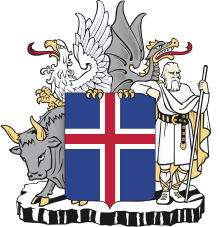Government and politics of Iceland
The form of government in Iceland is that of a parliamentary republic. The current republic was proclaimed on June 17, 1944. Since December 1, 1918, and until that day, Iceland had been a sovereign state under the Danish crown. After the constitutional referendum held in May of that year, which occurred while Denmark was occupied by Germany, the final independence was approved.
The Icelandic parliament, called Althing, was created in the year 930, which is why it is considered the oldest in the world. The seat of government is in the capital, Reykjavik.
Territorial organization
Iceland is organized into 23 counties (Icelandic: sýslur – singular: sýsla) and 14 independent cities (kaupstaðir, singular – kaupstadur).
For certain purposes —electoral districts, postal codes, statistical units, etc—, the territory is divided into eight regions.
Symbols
The flag of Iceland has a blue background with a red cross bordered in white extending to the edges. The vertical part of the cross is centered at the top as in the style of the Dannebrog (Danish flag).
The coat of arms of Iceland, "Skjaldamerkið", gathers the four mythical protective figures of the country ("landvættir") located on a block of lava and supporting the coat of arms that is made up of the same elements of the national flag.
The National Holiday is June 17, in commemoration of Independence Day (1944).
Executive branch
- Head of State: Chairman - Guðni Th. Jóhannesson (from August 1, 2016). The president has a ceremonial position and is elected by popular vote for a period of four years.
- Head of Government: Prime Minister — Katrín Jakobsdóttir (from November 30, 2017). The first minister is appointed by the president.
- Cabinet: appointed by the Prime Minister and approved by Parliament.
Legislative branch
Legislative power resides in a unicameral parliament called the Althing. Its 63 members are elected by popular vote for four-year terms. Iceland's legal system is a civil law system based on Danish law. Suffrage is universal, starting at 18 years of age.
Political parties
Following the 2017 Icelandic parliamentary elections eight parties were elected to form the Icelandic parliament:
| Name | Acronyms | Leader | Scalls |
|---|---|---|---|
| Independence Party
(Sjálfstæðisflokkurinn)) | D | Bjarni Benediktsson | 16 |
| Left-Verde Movement
(Vinstrihreyfingin – grænt framboð) | V | Katrin Jakobsdóttir | 11 |
| Progressive Party
(Framsóknarflokkurinn) | B | Sigurður Ingi Jóhannsson | 8 |
| Social Democratic Alliance
(Samfylkingin) | S | Logi Már Einarsson | 7 |
| Center Party
(Miðflokkurinn) | M | Sigmundur Davíð Gunnlaugsson | 7 |
| Pirate Party
(Pírataflokkurinn) | P | Collective leadership | 6 |
| People’s Party
(Flokkur fólksins) | F | Inga Sæland | 4 |
| Reform
(Viðreisn) | C | Benedikt Jóhannesson | 4 |
Participation in international organizations
BIS, CBSS, CCC, EC, EAPC, EBRD, ECE, European Free Trade Association (EFTA), FAO, IAEA, International Bank for Reconstruction and Development (World Bank), Australia Group, IATA: MAD, ICAO, ICC, ICFTU, ICRM, IDA, IEA (observer), IFAD, IFC, IFRCS, IHO, ILO, International Monetary Fund (IMF), IMO, Interpol, IOC, ISO, ITU, NATO, NC, NEA, NIB, OECD, OPCW, OSCE, PCA, UN, UNCTAD, Unesco, UNMIBH, UNMIK, UNU, UPU, WEU (associated), WHO, WIPO, WMO, World Trade Organization (WTO).
Contenido relacionado
Attila
Hatshepsut
Zapatista


